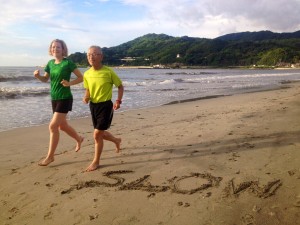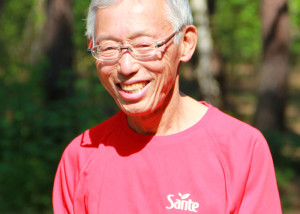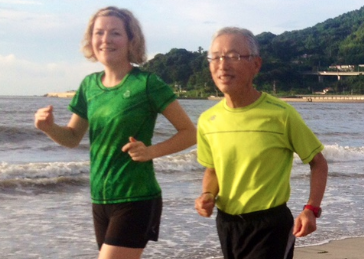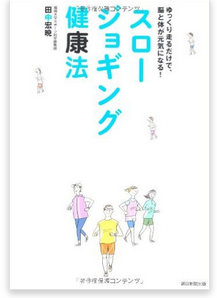 One of the most inspiring scientists and self-experimenting athletes is my good friend, Japanese running guru Dr. Hiro Tanaka. I had the privilege of first meeting Dr. Tanaka, a Professor at Fukuoka University, Japan, at the Boston Marathon in 2011 after giving a talk on minimal running and the benefits of “easy.” Dr. Tanaka showed me his heart rate and pace progression from building endurance, learning good form, and reducing the shoe. It led to a 2:38 marathon at age 50 plus. That is after reversing Type 2 Diabetes, his inspiration to start running again. Dr. Tanaka later came as a guest to the U.S. in 2012 for one of my Healthy Running courses and gave a community talk on “slow jogging.” In front of everyone, he demonstrated this easy and relaxed movement which almost anyone can do safely.
One of the most inspiring scientists and self-experimenting athletes is my good friend, Japanese running guru Dr. Hiro Tanaka. I had the privilege of first meeting Dr. Tanaka, a Professor at Fukuoka University, Japan, at the Boston Marathon in 2011 after giving a talk on minimal running and the benefits of “easy.” Dr. Tanaka showed me his heart rate and pace progression from building endurance, learning good form, and reducing the shoe. It led to a 2:38 marathon at age 50 plus. That is after reversing Type 2 Diabetes, his inspiration to start running again. Dr. Tanaka later came as a guest to the U.S. in 2012 for one of my Healthy Running courses and gave a community talk on “slow jogging.” In front of everyone, he demonstrated this easy and relaxed movement which almost anyone can do safely.
He also gave me a copy of his book published in Japanese, and whose title translated in English means “Run with Smile, Midfoot Strike.”
He is now working on translating the full work to English, but I wanted to share a chapter — see below — as well as two great photos of Dr.Tanaka, who is now in his early 60s.
 I am a big believer in “slow jogging” as a foundation for fitness and health. Master this to develop a soft and springy landing. You have to deserve to run hard and fast. Use “slow jogging” for recovery too; barefoot is best for this, in my opinion, to fully recover.
I am a big believer in “slow jogging” as a foundation for fitness and health. Master this to develop a soft and springy landing. You have to deserve to run hard and fast. Use “slow jogging” for recovery too; barefoot is best for this, in my opinion, to fully recover.
Dr. Tanaka’s approach is a throwback to what Bill Bowerman wrote about in his bestselling book “Jogging,” which came out nearly a half-century ago. Bowerman talked about easy running as the best way to train the cardiac, respiratory, and circulatory systems. Bowerman also mentioned that for beginners a walk/run style was ideal. For those who are new to the fitness routine, running is likely to be intense; however as people become more fit walking is not strenuous enough. So learning the skill of jogging and one’s journey to health will pay dividends as you become more fit and can spend more time jogging and less walking.
Here is how Bowerman defined jogging:
1. Jogging means a steady or an easy-paced running, while alternating with breath catching between periods of walking.
2. It means a kind of running, generally a slow regular trot that has been described as the next step up from walking.
3. Jogging describes the entire program of physical fitness outlined in this book.
The book — used copies of the out-of-print book can be found online at Amazon.com and elsewhere –went on to set the sample and safe plan which was used for cardiac patients by legendary coach Arthur Lydiard in New Zealand. The tables and charts are timeless and will progress almost anyone to 30 minutes in 12 weeks.
With “Slow Jogging,” Dr. Tanaka is expanding on the same foundation that Bowerman established, and millions of American followed. “Jogging” was a best-seller and sold over 1,000,000 copies. Perhaps that same kind of success awaits Dr. Tanaka.
For the time being anyway, the message for many runners is to “slow down!”
Thank you Dr Tanaka!
***
by Dr.Hiroaki Tanaka with Magdalena Jackowska
Until recently unknown outside of Japan, now gaining more and popularity worldwide, slow jogging is a method of running that I elaborated. The term “slow jogging” was chosen for emphasis, that even though we are talking about a sport traditionally associated with moving fast, slow can be a perfectly good way to do it.
Since as early as 1970s, I have been researching how exercise of low intensity but performed regularly, can help our health in many aspects, from obesity and metabolic syndrome to other diseases of affluence.
These days you can see people slow jogging everywhere in Japan. Many of them are the elderly, moving at 3-5km/h, which for most of us can be even slower than walking speed. There are also the busy Japanese, who already know that even short periods of exercise a few times a day can be beneficial to their health. Finally, there are experienced runners, who now alternate intense training with slow jogging, giving their bodies a chance to recover and remind themselves of the pure joy of running in fresh air, long forgotten somewhere in the tight training schedule.
Slow pace and smile
No matter how low your fitness level is, it’s very unlikely to be low enough to disqualify you from running. However, it can be, and often is, too low to run fast. That is why you need to start slowly – really slowly. Be warned – it’s highly possible, that you will be overtaken by surprised walkers.
The key to success is to keep your niko niko pace. Niko niko means “smile” in Japanese and here defines an easy pace, that you can keep with a smile. What’s important – niko niko pace can be very different for each one of us.
It happens, that an unfit 20 year-old has a niko niko pace similar to that of an average 70 year-old. Or the opposite – a 70 year-old marathoner can run as much as 8 to 10km per hour at his niko niko pace!
In scientific terms, niko niko is the pace that one can keep without significantly exceeding one’s lactate threshold. The easiest way is to listen to you body. If you are out of breath and not able to have a conversation, you should slow down – simple as that. Slow down to be able to talk at ease or if you are running alone – sing your favorite songs. For those of you who are at the beginning of their jogging adventure, niko niko pace will probably be lower that walking speed – we suggest to start at 3-5 km/h.
Landing makes all the difference
When walking, we usually make steps landing on the heel and pushing off with the forefoot in a heel-to-toe manner. When running, different patterns are possible – heel strike, similar to walking, or forefoot strike.
Let’s now try something. Stand up and jump a couple of times, right there, in a way the feels most natural. Now think about where you landed. Wasn’t it the upper-central part of your foot? Now, try to jump and land on your heels. It might be painful and probably you will not be able to jump very high… When landing on your forefoot, the Achilles tendon gives you natural elasticity that helps you to spring off your feet and jump higher.
Landing on your heels can cause a lot of pressure to your joints, and therefore increase the risk of injuries (threeimes higher, than when landing on your forefoot!). That happens because the collision of the heel to the ground generates an impact force, resulting in a shock to the body, minimal in the case of the forefoot strike.
To feel and remember what kind of movement we are talking about, try jogging in place, jumping, jogging backwards or barefoot – that is when your feet move naturally and the movement we will aim at when jogging as well. Just be careful – we are not talking about jogging on your tiptoes, but about using the upper-central, widest part of your foot.
Unfortunately, most of the modern running shoes, especially designed for beginners, have a thick sole invented to minimize shocks resulting from landing on the heels. However, such a construction makes you land on the heel and inhibits the instinctive movement. Slow jogging and forefoot running require going back to basics and the instinctive way of running, so simple shoes with thin, elastic soles, fitting well on the heel and wide enough in the toe part are strongly recommended.
Ready?
So now when you have your shoes and you know how to land – it is time to move forward. Imagine, that your body is a pole, straight from head to forefoot. Imagine that your legs are making small steps on two separate, parallel tracks. Make use of your Achilles tendon to small jumps and landing on the forefoot. Running or jogging is just a sequence of small jumps on alternate legs so there is no need to kick or apply force to the ground. You will often see runners putting their feet in one straight line – that means that they have to make extra body turns which results in unnecessary energy loss. And also, turns of the pelvis increase the stress on the knees and thus risk of injuries. Next time take a good look at how the children run and imitate their two-track movements.
Pay attention to your whole body as well. You should be straight in your hips and watch the horizon – not your feet. As far as the arms are concerned, you do not have to control them consciously. Form 90 degrees angles with your elbows, clench your fists lightly imagining you are holding skiing poles, relax your shoulders and swing the arms gently forward and back.
Step by step
Just as the majority of amateur runners, you probably never thought about your cadence, which is the numbers of steps you make. Try now – right there were you are: jog for 15 seconds and count your single steps.
What’s your number? For beginners it would usually be between 35 and 44, whereas for professional runners it is on average higher. You got 45 or more? Congratulations – that’s the ideal cadence! And if yours was lower – try 15 seconds of jogging, while again consciously aiming at 45.
Remembering this rhythm now will also come in handy later on. If at some point you get faster and want to participate in a race, you will not need to change your rhythm, just the stride length which is length of a singular step.
For very low speed your stride will be very short, about 1/3 of what you would thing of as average running stride.
To sum up – aim at 180 steps per minute, which is 45 steps per 15 seconds. For the speed of 3km/h it will mean a single step of almost 30 cm, and almost 40 for 4km/h.
How do you breathe?
During walking or any other activity you breathe following your instincts, don’t you? It’s completely automatic, so all you need to do is trust nature.
For some reason, we are often asked about breathing while running. Is it true that it is better to breathe in by your nose and out by your mouth?
Even with walking, the oxygen demand increases with speed, which makes you breathe faster and your heart beat faster. When you walk slowly, your energy expenditure is three times higher that when sitting still, five times higher for brisk walking and six times when climbing the stairs. Still – in none of the examples above, you are not consciously controlling the way you breathe. With no effort on your part, your lungs as well as the heart are automatically adjusting themselves to the activity performed. When slow jogging it’s enough to trust your instincts – don’t push yourself into breathing through your nose, just smile and get going – chatting or singing.
Too busy to exercise?
We can assure you that in 24 hours you will find plenty occasions to jog – even for a few minutes each time. I slow jog on the way to work, between classrooms or during business trips at the airport or even at the back of the plane. It’s usually slow jogging in intervals: 1 minute jogging followed by 30 seconds walking. That’s the easiest way to start, particularly recommended for beginners. Try it next time walking your dog or on the way to the supermarket – and don’t forget about the smile!
How about experienced runners?
I’m not going to tell you to jog at 4km/h if you train usually at 4 minutes per kilometer. But no matter what your speed and experiences are, l strongly recommend to learn (or remind yourself of) listening to your body and avoiding injuries. Contrary to what you might think now, it is really not that hard to complete a marathon, or just under that for a 42-kilometer run. It is much harder to enjoy safe and injury-free running for 42 years.
Sometimes among training plans and improving your race results, it is a good idea to slow down and analyze your technique – being able to run fast does not necessarily mean it will be running of good quality and efficiency. Actually those “running” closest to professional athletes are children and the elderly, who participate in our slow jogging workshops for the first time. And close to nature at the same time – since running is the most intuitive form of movement, present in human lives since… ever. I’m not trying to tell you that slow jogging itself is a revolution — it is more of a conscious return to nature and simplicity.
It all makes the Japanese method so powerful – depending on personal needs and abilities, everyone can enjoy it in his or her own way – be it for health, fun or both.Slow jogging itself can be a goal or it can become a first step in a bigger running adventure, that you can (and we hope you will!) enjoy for many years to come.



I Loved the article about by Dr. Tanaka
Where can you find more information on his Marathon Method
I currently use Phill Maffertones 180 Endurance Method
Like to know how much or little fast runs he put in to run a 2:38 Marathon at 50 That’s a great time!!!
Daryl Campbell
Hello Mark,
I think it was Lydiard who set Bill Bowerman on the jogging track. Otherwise, Nice article.
Greetings
yes, you are 100% correct.
Hello! I am from Romania. It’s great to dicover this post about slow jogging technique. I am a begginer in this healthy way of life. I try to change my lifestyle to improve cardiovascular system and more. Does exist a 5k plan for this slow jogging? Thanks!
I bought the book and love it, but what I find sadly missing are any training tables that would give me an idea how to best begin and implement what I learned from the book so far. I also tried to get Bill Bowerman’s book “Jogging” since it was mentioned in the “Slow Jogging” book, but even the used copies came with quite a price tag. Do you know where I could find a Slow Jogging training plan for beginners (even though I’ve been a runner for many years, I had a long hiatus of over a year due to an injury and so I want to start very slowly). Your help/ advice would be greatly appreciated!
sunny start with a walk/jog program as your body feels it is adapting. hard to put this on paper as each is different. slow, comfortable and progressive. mark
inspiring , i will try this technique for 2018 resolution “Run”
May I know what shoes brand recommended for slow jogging?
kay really anything light, wide, flexible. best is your barefeet if you have healthy feet 🙂
Mark,
Would.Sketchers Go Walk be good for a brand new beginner?
yes! light and low drop
Is there a certain brand or type I should look for?
any light , flat, low drop shoe. or barefoot 🙂
Sorry, the last part. 4kmph, isn’t it 15 mins/km? Ok, I am just being an ass…
yes super slow is beddy beddy good for you!
Hi
I read the book and understand the concept. However, it is assumed that if you train at your niko pace that your speed will increase over time while keeping the intensity the same? Please explain. Otherwise it would take 3 days to finish 26.2 miles.
you build aerobic capacity so the easy pace actually gets faster over time 🙂
Hello,
I just ran into “slow jogging” last week and have since been addicted to that method when I go on a run. I used to follow Chi running but ever since I finished the book, I have applied slow jogging to my training and have never felt better! My question is when you race do you use the Niko Niko pace and slow jogging or do you use those two just for training? Thank you again for opening my eyes to a new way of training. I have become a fan of everyone involved with Slow Jogging!
You have a comprehension problem dude? Slow jogging is a different thing in itself. It builds your body the same way that running would but without any risk of injury. When you race, you are doing something else. What did you think? When you slow jog in a race, an angel from heaven will pick you and drop you at the finish line before the others? If you slow jog at 3mph in a marathon, it will take you 9hrs to complete. That’s simple maths. When they mention Tanaka doing it in 2.38 hr, it was meant to illustrate how slow jogging built his body so he could “run” the marathon in that short of a time.
I’d really appreciate more specific advice on shoes. There’s an global abundance of brands and models? What are the keywords I should be looking for? Neutral? Any recommended brands or models as a starting point?
Hi,
What is the suitable running shoe for slow jogging?
45 steps in 15 seconds?
Thats THREE steps every second?
Impossible….